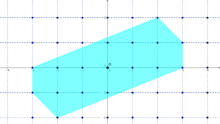Minkowski's theorem
In mathematics, Minkowski's theorem is the statement that every convex set in which is symmetric with respect to the origin and which has volume greater than contains a non-zero integer point. The theorem was proved by Hermann Minkowski in 1889 and became the foundation of the branch of number theory called the geometry of numbers. It can be extended from the integers to any lattice and to any symmetric convex set with volume greater than , where denotes the covolume of the lattice (the absolute value of the determinant of any of its bases).

Formulation
Suppose that L is a lattice of determinant d(L) in the n-dimensional real vector space ℝn and S is a convex subset of ℝn that is symmetric with respect to the origin, meaning that if x is in S then −x is also in S. Minkowski's theorem states that if the volume of S is strictly greater than 2n d(L), then S must contain at least one lattice point other than the origin. (Since the set S is symmetric, it would then contain at least three lattice points: the origin 0 and a pair of points ±x, where x ∈ L \ 0.)
Example
The simplest example of a lattice is the integer lattice ℤn of all points with integer coefficients; its determinant is 1. For n = 2, the theorem claims that a convex figure in the Euclidean plane symmetric about the origin and with area greater than 4 encloses at least one lattice point in addition to the origin. The area bound is sharp: if S is the interior of the square with vertices (±1, ±1) then S is symmetric and convex, and has area 4, but the only lattice point it contains is the origin. This example, showing that the bound of the theorem is sharp, generalizes to hypercubes in every dimension n.
Proof
The following argument proves Minkowski's theorem for the specific case of L = ℤ2. It can be generalized to arbitrary lattices in arbitrary dimensions.
Consider the map
Intuitively, this map cuts the plane into 2 by 2 squares, then stacks the squares on top of each other. Clearly f(S) has area less than or equal to 4, because this set lies within a 2 by 2 square. Assume for a contradiction that f could be injective, which means the pieces of S cut out by the squares stack up in a non-overlapping way. Because f is locally area-preserving, this non-overlapping property would make it area-preserving for all of S, so the area of f(S) would be the same as that of S, which is greater than 4. That is not the case, so the assumption must be false: f is not injective, meaning that there exist at least two distinct points p1, p2 in S that are mapped by f to the same point: f(p1) = f(p2).
Because of the way f was defined, the only way that f(p1) can equal f(p2) is for p2 to equal p1 + (2i, 2j) for some integers i and j, not both zero. That is, the coordinates of the two points differ by two even integers. Since S is symmetric about the origin, −p1 is also a point in S. Since S is convex, the line segment between −p1 and p2 lies entirely in S, and in particular the midpoint of that segment lies in S. In other words,
is a point in S. But this point (i,j) is an integer point, and is not the origin since i and j are not both zero. Therefore, S contains a nonzero integer point.
Applications
An application of this theorem is the result that every class in the ideal class group of a number field K contains an integral ideal of norm not exceeding a certain bound, depending on K, called Minkowski's bound: the finiteness of the class number of an algebraic number field follows immediately.
Minkowski's theorem is also useful to prove Lagrange's four-square theorem, which states that every natural number can be written as the sum of the squares of four natural numbers.
Further reading
- Bombieri, Enrico; Gubler, Walter (2006). Heights in Diophantine Geometry. Cambridge University Press. ISBN 9780521712293.
- Cassels, J.W.S. (2012) [1959]. An Introduction to the Geometry of Numbers. Classics in Mathematics. Springer. ISBN 978-3-642-62035-5.
- Conway, John; Sloane, Neil J. A. (29 June 2013) [1998]. Sphere Packings, Lattices and Groups (3rd ed.). Springer. ISBN 978-1-4757-6568-7.
- Hancock, Harris (2005) [1939]. Development of the Minkowski Geometry of Numbers. Dover Publications. ISBN 9780486446400.
- Hlawka, Edmund; Schoißengeier, Johannes; Taschner, Rudolf (2012) [1991]. Geometric and Analytic Number Theory. Springer. ISBN 978-3-642-75306-0.
- Lekkerkerker, C.G. (2014) [1969]. Geometry of Numbers. Elsevier. ISBN 978-1-4832-5927-7.
- Schmidt, Wolfgang M. (1980). Diophantine approximation. Lecture Notes in Mathematics. 785. Springer. doi:10.1007/978-3-540-38645-2. ISBN 978-3-540-38645-2. ([1996 with minor corrections])
- Wolfgang M. Schmidt.Diophantine approximations and Diophantine equations, Lecture Notes in Mathematics, Springer Verlag 2000.
- Siegel, Carl Ludwig (2013) [1989]. Lectures on the Geometry of Numbers. Springer-Verlag. ISBN 9783662082874.
- Schneider, Rolf (1993). Convex Bodies: The Brunn-Minkowski Theory. Cambridge University Press. ISBN 978-0-521-35220-8.
External links
- "Minkowski's theorem". PlanetMath.
- Stevenhagen, Peter. Number Rings.
- Malyshev, A.V. (2001) [1994], "Minkowski theorem", in Hazewinkel, Michiel (ed.), Encyclopedia of Mathematics, Springer Science+Business Media B.V. / Kluwer Academic Publishers, ISBN 978-1-55608-010-4
- Hazewinkel, Michiel, ed. (2001) [1994], "Geometry of numbers", Encyclopedia of Mathematics, Springer Science+Business Media B.V. / Kluwer Academic Publishers, ISBN 978-1-55608-010-4